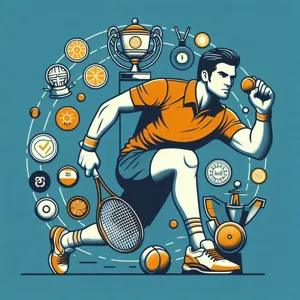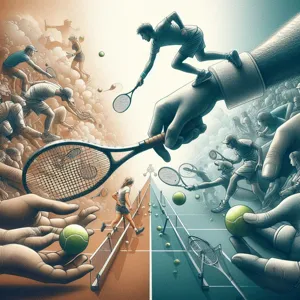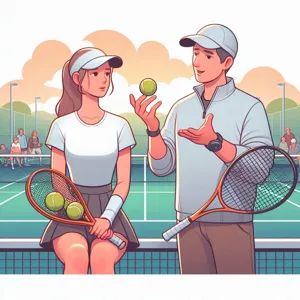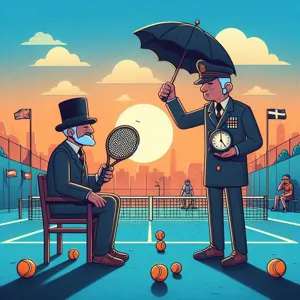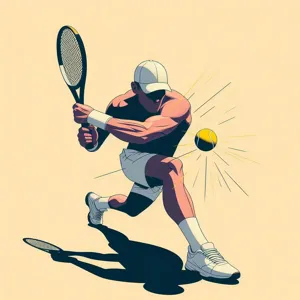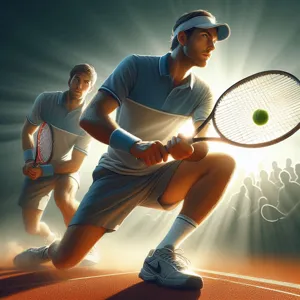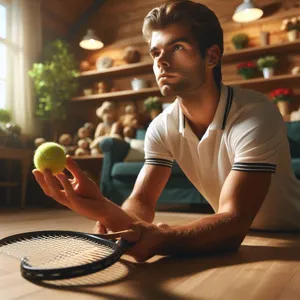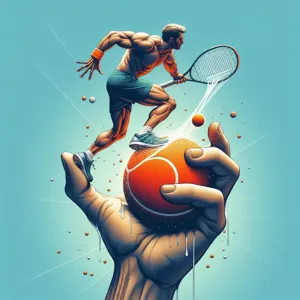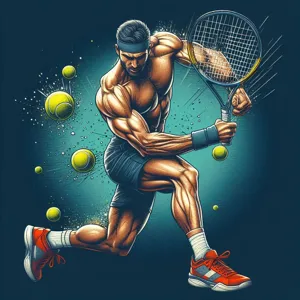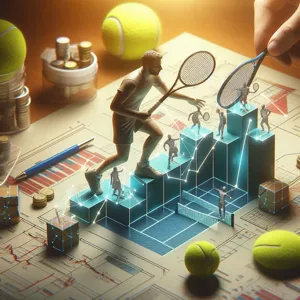In the world of tennis, success is often measured not just by physical prowess but by the strength of one’s mindset.
Whether you’re a seasoned player or a budding enthusiast, the mental game is a pivotal component that can elevate your performance on the court to new heights. Cultivating a winning mindset involves more than just managing pressure during crucial points; it requires resilience, focus, and the ability to embrace challenges as opportunities for growth. As you step onto the court equipped with racquet in hand, the right mental approach can turn the tide in your favor, helping you to navigate the highs and lows of competition with grace and determination. In this blog post, we will explore essential strategies and techniques for mastering your mental game, empowering you to cultivate a winning mindset that will not only enhance your skills but also enrich your overall experience in tennis. Join us as we delve into the psychology of champions and discover how to harness the power of your mind to achieve greatness on the court!
1. Understanding the Winning Mindset in Tennis
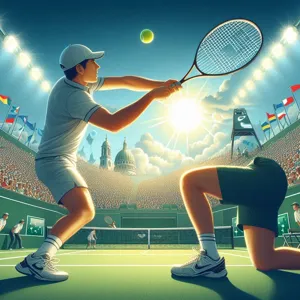
The winning mindset in tennis is more than just a collection of positive thoughts; it is a comprehensive approach to the game that intertwines mental resilience, strategic thinking, and emotional control. At its core, a winning mindset involves a deep understanding of both the player’s strengths and weaknesses, as well as an unwavering belief in their ability to overcome challenges. This mindset begins with self-awareness—recognizing how you react under pressure, identifying areas for improvement, and celebrating your unique style of play.
Central to this mentality is the ability to maintain focus and clarity during matches, especially when faced with adversity. A player with a winning mindset views obstacles not as insurmountable barriers but as opportunities for growth. They embrace the inevitability of setbacks, using them as stepping stones rather than stumbling blocks. Visualization techniques can play a significant role here; by mentally rehearsing successful plays and scenarios, players can prime themselves for peak performance on the court.
Furthermore, emotional control is key to maintaining a winning mindset. Tennis is as much a psychological battle as it is a physical one, and the ability to manage emotions—whether it’s the thrill of winning a crucial point or the frustration of a missed opportunity—can make all the difference. Players who cultivate a winning mindset learn to channel their emotions productively, transforming anxiety into energy and frustration into determination.
Ultimately, understanding the winning mindset in tennis is about cultivating a holistic approach that combines mental toughness, strategic acumen, and emotional intelligence. By developing these attributes, players not only enhance their performance on the court but also foster a lifelong love for the game, allowing them to navigate both victories and defeats with grace and resilience.
2. The Importance of Mental Toughness
Mental toughness is the cornerstone of success in tennis, where the physical demands of the game often pale in comparison to the psychological challenges players face on the court. The pressure of competition, the weight of expectations, and the relentless pursuit of perfection can easily overwhelm even the most talented athletes. This is where mental resilience becomes an essential asset, allowing players to navigate adversity with grace and determination.
Imagine standing at the baseline, preparing to serve for match point. The crowd is buzzing, your opponent is laser-focused, and the stakes couldn’t be higher. In this moment, it’s not just your physical skills that will determine the outcome; it’s your mental fortitude. A mentally tough player can block out distractions, manage nerves, and maintain composure under pressure. They possess the ability to stay positive and focused, even when the match isn’t going their way.
Building mental toughness involves cultivating a set of skills that can be developed through practice and experience. Visualization techniques can help players mentally rehearse their performance, envisioning success shot by shot. Positive self-talk is another powerful tool, replacing negative thoughts with affirmations that empower and encourage. Furthermore, embracing failure as a learning opportunity rather than a setback fosters resilience, enabling players to bounce back stronger after a tough loss.
Ultimately, mental toughness in tennis is about mastering the mind as much as mastering the game itself. It transforms obstacles into opportunities and fuels the relentless pursuit of improvement. When you cultivate a winning mindset, you not only enhance your performance on the court but also develop a deeper love and appreciation for the sport, paving the way for a fulfilling tennis journey.
3. Setting Goals: Short-term vs. Long-term

Setting goals is a fundamental aspect of cultivating a winning mindset in tennis, and understanding the distinction between short-term and long-term goals can significantly enhance your performance on and off the court.
**Short-term goals** are the stepping stones that pave the way for your larger aspirations. They often focus on immediate improvements, such as perfecting your serve, increasing your match stamina, or refining your footwork. These goals are typically specific, measurable, and achievable within a shorter timeframe, such as weeks or months. For instance, you might set a short-term goal to practice your backhand for at least 30 minutes during each training session over the next month. Celebrating these small victories not only boosts your confidence but also keeps you motivated as you witness tangible progress.
On the other hand, **long-term goals** provide a broader vision for your tennis journey. These are the ambitions that inspire you to push your limits and strive for excellence over an extended period, often spanning years. Long-term goals may include aspirations such as competing at a higher level, earning a spot on your school’s varsity team, or even participating in national tournaments. It’s essential to keep these aspirations in mind as they shape your training regimen and decision-making process. For example, if your long-term goal is to compete in a regional championship next year, your short-term goals should align with that vision, ensuring each practice session contributes to your overall development and readiness for the competition.
By strategically balancing short-term and long-term goals, you create a roadmap that not only enhances your skills but also fosters resilience and determination. As you work towards these objectives, remember to stay flexible; adapting your goals in response to challenges and victories alike is key to maintaining a winning mindset. Ultimately, the synergy between your short-term achievements and long-term aspirations will propel you forward, ensuring that you remain focused and inspired on your tennis journey.
4. Visualization Techniques for Success
Visualization techniques are a powerful tool that can transform your mental approach to the game of tennis and significantly enhance your performance on the court. Athletes across disciplines have long recognized the benefits of visualizing success, and tennis is no exception. By vividly imagining your ideal performance — from the perfect serve to executing a flawless backhand — you can create a mental blueprint that primes your body for success.
Start by finding a quiet space where you can focus without distractions. Close your eyes and take a few deep breaths to center yourself. Picture the court, the feel of the racket in your hand, and the sound of the ball striking the strings. Envision yourself in a match situation, visualizing not just the shots you want to make, but also the emotions you want to experience: confidence, determination, and joy. See yourself moving gracefully across the court, anticipating your opponent’s shots, and responding with precision and power.
Research shows that athletes who regularly practice visualization techniques can improve their focus, reduce anxiety, and boost overall performance. This mental rehearsal allows you to prepare for various scenarios, helping you to react more instinctively during actual matches. Remember, visualization is not just about seeing the perfect shot; it’s also about overcoming obstacles, such as facing a tough opponent or recovering from a mistake.
Incorporating visualization into your training routine can lead to a more resilient mindset. Spend a few minutes each day visualizing your goals, whether it’s winning a local tournament or improving your serve percentage. The more vividly and frequently you picture your success, the more real it becomes. This practice not only enhances your mental game but also reinforces a positive self-image, making you feel more capable and ready to take on challenges when they arise.
By mastering visualization techniques, you’ll cultivate a winning mindset that not only elevates your game but also makes the journey to success in tennis a more fulfilling and enjoyable experience.
5. Developing Focus and Concentration

In the fast-paced world of tennis, the ability to focus and concentrate can often be the deciding factor between victory and defeat. Developing this crucial skill goes beyond simply keeping your eyes on the ball; it involves a holistic approach that nurtures your mental resilience, enhances your decision-making, and boosts your overall performance on the court.
To cultivate focus, start by establishing a pre-match routine that primes your mind for peak performance. This could include visualization techniques, where you imagine yourself executing perfect serves or winning critical points. By mentally rehearsing scenarios, you create a cognitive blueprint that sets you up for success when it matters most.
During practice sessions, embrace mindfulness exercises that sharpen your concentration. This might involve dedicating specific drills to honing your attention, such as playing points with distractions—whether it’s music in the background or teammates engaging in nearby drills. By training your mind to stay centered amidst chaos, you bolster your ability to maintain focus during high-pressure moments in matches.
Additionally, consider integrating breathing techniques into your training. Deep, intentional breaths can help ground you, reduce anxiety, and refocus your thoughts when distractions arise. When you feel your mind wandering during a match, remember to pause and take a breath, allowing the clarity to wash over you like a refreshing wave, guiding you back to the task at hand.
Lastly, remember that developing focus is an ongoing journey. Regularly assess your mental state and make adjustments as necessary, whether through reflection after matches or journaling about your experiences. By committing to this continuous improvement, you’ll not only enhance your concentration but also cultivate a winning mindset that empowers you to take on any opponent with confidence and tenacity.
6. Embracing Positive Self-Talk
In the high-stakes world of tennis, where every match can swing on a single point, embracing positive self-talk can be your secret weapon. The mind is a powerful tool, and how you speak to yourself can significantly influence your performance on the court. Instead of allowing negative thoughts to creep in—“I can’t believe I missed that serve” or “I’m going to lose this match”—shift your internal dialogue to something more constructive and uplifting.
Start by identifying the common phrases that run through your mind during a match. Are they supportive or self-defeating? Once you have this awareness, consciously replace those negative affirmations with positive ones. Phrases like “I am capable of hitting powerful serves” or “Every point is a new opportunity” can shift your mindset, instilling confidence and resilience.
Practicing positive self-talk doesn’t just help during matches; it’s a skill that can be honed during training sessions as well. When you hit a difficult shot or struggle with your footwork, instead of berating yourself, remind yourself that mistakes are part of the learning process. Each time you catch yourself engaging in negative self-talk, take a breath and reframe your thoughts. Over time, this practice will not only enhance your performance but will also foster a more enjoyable experience on the court.
Moreover, consider the power of visualization in tandem with self-talk. Before a match, visualize yourself playing confidently and successfully, reinforcing those positive affirmations in your mind. This combination of self-talk and visualization can create a powerful mental framework that prepares you to tackle challenges head-on.
Embracing positive self-talk is about cultivating a mindset that believes in your capabilities and celebrates your journey as a player. By nurturing this supportive inner voice, you’ll find yourself not only improving your game but also enjoying the sport on a deeper level. So next time you step onto the court, remember: the way you talk to yourself can be just as important as your physical training. Choose positivity, and watch your performance soar.
7. Overcoming Fear of Failure

Overcoming the fear of failure is a crucial aspect of cultivating a winning mindset in tennis. This fear can often manifest as anxiety before a match, hesitation during critical points, or even an overwhelming urge to avoid competition altogether. Understanding that failure is not the opposite of success but rather a part of the journey can transform your perspective and approach to the game.
To combat this fear, start by reframing your mindset. Instead of viewing failure as a definitive end, see it as an opportunity for growth and learning. Every missed shot or lost match is a chance to analyze what went wrong and how you can improve moving forward. Embrace each setback as a stepping stone towards your ultimate goals, rather than a roadblock.
Another effective strategy is to set realistic and achievable goals. Focus on the process rather than the outcome. For instance, instead of fixating on winning a tournament, set goals related to your technique, strategy, or mental preparation. This shift in focus allows you to channel your energy into aspects of the game that you can control, minimizing the dread of potential failure.
Visualization techniques can also be powerful. Spend time imagining yourself executing your shots flawlessly, handling pressure with composure, and ultimately succeeding. This mental rehearsal can build your confidence and diminish the fear associated with failure.
Lastly, surround yourself with a supportive community. Engage with coaches, teammates, and fellow players who encourage a positive environment where mistakes are seen as a natural part of the learning curve. When you realize that you’re not alone in your experiences, the weight of fear begins to lift.
By actively working to overcome the fear of failure, you not only enhance your mental resilience but also open yourself up to a world of possibilities on the court. Embrace the journey with all its ups and downs, and you’ll find that a winning mindset is within your reach.
8. The Role of Routine in Performance
In the fast-paced world of tennis, where every match can swing on the tiniest of margins, the importance of routine cannot be overstated. A well-structured routine serves as the backbone of a player’s mental game, providing a sense of stability amid the chaos of competition. Routine is not just about the physical actions performed before a match; it’s a holistic approach that intertwines mental preparation, emotional regulation, and physical readiness.
For many top players, establishing a pre-match ritual is essential. This might include specific warm-up exercises, visualization techniques, or a series of stretches that not only prepare the body but also calm the mind. By consistently engaging in these rituals, players condition themselves to enter a focused state, allowing them to drown out distractions and hone in on their performance.
Moreover, routines can extend beyond just the hours leading up to a match. Developing consistent practices during training—such as a specific order of drills, playback of match footage, or even dietary habits—can foster a sense of familiarity that translates into confidence on the court. Regularly engaging in these routines reinforces muscle memory and sharpens mental acuity, enabling players to respond instinctively to the demands of the game.
Equally important is the role of routines in managing the emotional rollercoaster that often accompanies competitive play. Whether it’s a pivotal tie-break or a match point, having a routine helps players maintain composure and focus, reducing the likelihood of being overwhelmed by pressure. In these high-stakes moments, a simple act—like bouncing the ball a certain number of times before serving—can ground a player and remind them of their training.
In summary, the role of routine in performance is integral to cultivating a winning mindset in tennis. By establishing consistent practices that encompass physical, mental, and emotional elements, players can create a powerful framework that enhances their performance and resilience on the court. Embrace the power of routine, and watch as it transforms your game, one match at a time.
9. Learning from Losses: Turning Setbacks into Growth
In the world of tennis, losses are as inevitable as the sun rising each day. Every player, from aspiring amateurs to seasoned professionals, will face defeat at some point in their journey. However, the true test of a champion lies not in the number of wins accumulated but in how they respond to setbacks. Learning from losses is crucial for cultivating a winning mindset, and it can serve as a powerful catalyst for personal and athletic growth.
After a tough match, it’s all too easy to succumb to frustration or disappointment. But instead of wallowing in negativity, take a step back and analyze the experience. What went wrong? Were there specific strategies or techniques that faltered? Did nerves play a role in performance? By reflecting on these questions, you can gain invaluable insights into your game. This process transforms a painful defeat into a learning opportunity, allowing you to identify weaknesses and make adjustments for future matches.
Consider the stories of some of tennis’s greatest champions. Many have shared tales of early career losses that initially felt like insurmountable obstacles. Yet, they chose to embrace these experiences as part of their development. They studied their performance, sought feedback from coaches, and committed to relentless practice. This mindset of resilience not only improved their skills but also fortified their mental toughness—an essential trait for success in tennis.
Additionally, maintaining a positive outlook is vital. Instead of viewing losses as failures, consider them stepping stones on the path to mastery. Each defeat is a chance to refine your technique, enhance your strategy, and deepen your understanding of the game. By framing your mindset in this way, you can cultivate a sense of curiosity and eagerness to improve rather than dread or fear of losing.
Moreover, sharing your experiences with fellow players can provide a support system that fosters growth. Discussing matches with teammates or mentors can unveil new perspectives and strategies that you might not have considered on your own. This collaborative approach not only helps in processing the loss but also reinforces a sense of community and camaraderie among players.
In essence, learning from losses in tennis is about more than just analyzing match data; it’s a profound journey of self-discovery and resilience. By embracing setbacks as opportunities for growth, you’ll not only become a better player on the court but also develop a mindset that transcends tennis, preparing you to tackle challenges in all aspects of life. Remember, every great champion is shaped by their defeats—so when you lose, harness that experience to fuel your future successes.
10. Strategies for Staying Calm Under Pressure
In the fast-paced world of tennis, where every serve, volley, and forehand can pivot the outcome of a match, maintaining composure under pressure is paramount. The ability to keep a cool head not only enhances your performance but also allows you to seize control of the game when the stakes are highest. Here are some effective strategies to cultivate that winning calmness.
**1. Mindfulness and Breathing Techniques:** Before stepping onto the court, take a moment to center yourself. Practicing mindfulness through focused breathing can help ground your thoughts. Inhale deeply through your nose for a count of four, hold for four, then exhale slowly through your mouth for another four counts. This simple exercise can reduce anxiety and keep you present in the moment.
**2. Visualization:** Create a mental image of yourself succeeding under pressure. Picture yourself in a critical point of the match—perhaps facing match point against you—and visualize how you would react. Imagine the sound of the crowd, the feel of the racket in your hand, and the sensation of executing the perfect shot. By rehearsing these scenarios mentally, you can build confidence and reduce anxiety.
**3. Positive Self-Talk:** The words you say to yourself can significantly impact your mindset. Replace negative thoughts with positive affirmations. Instead of thinking, “I can’t believe I missed that shot,” try saying, “I’m capable of playing my best game.” This shift in narrative can boost your confidence and help maintain focus during tense moments.
**4. Develop a Routine:** Establishing a pre-serve or pre-point routine can create a sense of familiarity and control. Whether it’s bouncing the ball a specific number of times, adjusting your grip, or taking a moment to scan the court, find a sequence that helps you relax and refocus. Consistency in your routine can signal your brain to settle down and prepare for the task at hand.
**5. Focus on the Process, Not the Outcome:** Instead of obsessing over the final score or the need to win, concentrate on the mechanics of your game. Focus on your footwork, your swing, and executing your strategy. By redirecting your attention to the process, you can diminish the weight of the outcome, allowing you to play more freely and effectively.
Incorporating these strategies into your training and match play can fortify your mental resilience. Remember, the mental game is just as important as the physical one in tennis. By mastering your mindset, you’ll not only enhance your performance but also enjoy the game even more, no matter the pressure of the moment.
11. Building Resilience Through Visualization and Mindfulness
In the competitive world of tennis, resilience is often the secret ingredient that separates the champions from the rest. Building this essential trait can be significantly enhanced through the powerful practices of visualization and mindfulness. These techniques not only bolster mental fortitude but also create a profound connection between the mind and body, allowing players to navigate the highs and lows of the game with confidence and poise.
**Visualization** is a technique employed by many top athletes, and it involves creating vivid mental images of success. Imagine standing on the court, feeling the sun warming your back, the sound of the ball hitting your racket, and the adrenaline coursing through your veins as you execute a perfect serve. By regularly visualizing these scenarios, you train your brain to respond positively under pressure. Research suggests that this practice can enhance performance by reinforcing neural pathways, making the execution of skills more instinctive during actual matches.
On the other hand, **mindfulness** encourages players to remain present, focusing on the current moment rather than dwelling on past mistakes or future outcomes. This practice can be as simple as taking a few deep breaths before each point or incorporating brief meditation sessions into your routine. By cultivating an awareness of your thoughts and feelings, you can reduce anxiety and improve your concentration. Mindfulness teaches players to embrace the ebb and flow of matches, allowing them to recover from setbacks and maintain their composure amid the chaos of competition.
Together, visualization and mindfulness create a powerful toolkit for building resilience. As you integrate these practices into your training regimen, you will find that not only do you perform better under pressure, but you also develop a greater appreciation for the journey of mastering your game. Embrace these techniques, and watch as your mental strength transforms your overall performance on the court, helping you to bounce back from challenges and continue on the path to greatness.
12. The Influence of Body Language on Mindset
In tennis, the power of body language extends far beyond mere posture or facial expressions; it can significantly influence both your personal mindset and the perceptions of your opponents. When you step onto the court, your body speaks volumes, often conveying emotions that you might not verbalize. A confident stance, a strong grip on the racket, and purposeful movements can project an aura of determination and focus. Conversely, slumped shoulders, averted gazes, and hesitant steps can signal doubt or frustration, not only to your opponent but also to yourself.
Studies have shown that adopting an open and assertive posture can actually enhance your mental state. This concept, often referred to as “power posing,” suggests that standing tall and occupying space can elevate your confidence levels and reduce feelings of anxiety. Imagine entering a match with your head held high, chest out, and a firm grip on your racket—these small adjustments can shift your internal dialogue from one of uncertainty to a mindset brimming with self-assurance.
Moreover, your body language can influence your rival’s mindset as well. A player who exudes confidence may intimidate opponents, causing them to second-guess their strategies or feel pressured. Conversely, if you show signs of defeat or frustration, you may inadvertently empower your opponent, allowing them to seize the psychological advantage.
Incorporating mindful body language into your game requires practice and self-awareness. Before matches, take a moment to center yourself and visualize your success while adopting a posture that reflects that vision. Focus on your breathing, maintain eye contact with your coach or teammates, and remember to smile—this not only boosts your own morale but can also create a positive atmosphere around you. By mastering the influence of body language, you can foster a winning mindset that permeates every aspect of your game, enhancing both your performance and your enjoyment of tennis.
13. Creating a Supportive Environment
Creating a supportive environment is crucial for developing a winning mindset in tennis. The mental aspect of the game can often be just as challenging as the physical demands, and having a strong support system can make all the difference. Surrounding yourself with positive influences, whether they be coaches, teammates, family, or friends, fosters an atmosphere that encourages growth and resilience.
Start by evaluating your inner circle. Seek out those who uplift and inspire you, who understand the challenges of the sport and can provide motivation during tough times. A supportive coach can help you refine your technique while also being a source of encouragement when self-doubt creeps in. Teammates who share a similar drive can create a culture of camaraderie, pushing each other to improve and celebrate each other’s successes.
Moreover, consider the physical environments where you train and compete. Opt for facilities that promote a positive atmosphere, whether it’s through encouraging staff, well-maintained courts, or a community that values sportsmanship and respect. This sense of belonging can bolster your confidence and performance on the court.
Finally, don’t underestimate the power of self-talk and personal affirmations. Cultivating a supportive inner dialogue is just as important as external encouragement. Replace negative thoughts with empowering statements that reinforce your abilities and goals. This dual approach—surrounding yourself with positive influences while nurturing a constructive mindset—will empower you to face challenges head-on and ultimately thrive in the competitive world of tennis.
14. Incorporating Mindfulness and Meditation Practices
Incorporating mindfulness and meditation practices into your tennis regimen can transform not only your performance on the court but also your overall approach to the game. The fast-paced nature of tennis, with its intense rallies and high-pressure moments, can often lead to anxiety and distraction. By embracing mindfulness, you can ground yourself, sharpen your focus, and enhance your emotional resilience.
Start by setting aside a few minutes each day for meditation. Find a quiet space, sit comfortably, and close your eyes. Focus on your breath, allowing each inhale and exhale to bring you deeper into a state of calm. As thoughts arise—perhaps about your last match or upcoming tournament—acknowledge them without judgment and gently bring your focus back to your breathing. This practice cultivates an awareness that can transcend the meditation session and carry into your time on the court.
During matches, mindfulness can help you remain present and engaged, rather than getting lost in the score or the expectations you place upon yourself. Techniques such as visualizing your ideal shot or mentally reciting a mantra can help center your thoughts and reduce performance anxiety. For instance, as you prepare to serve, repeating a phrase like “calm and focused” can anchor your mind, allowing you to execute your strategy with clarity.
Moreover, incorporating mindfulness into your training sessions can improve your ability to learn from mistakes. Rather than dwelling on a missed shot or a lost point, practicing self-compassion and mindfulness enables you to reflect constructively, fostering a growth mindset. You’ll begin to see challenges as opportunities for improvement rather than setbacks, ultimately enhancing your mental toughness.
As you weave mindfulness and meditation into your routine, you’ll not only enrich your tennis game but also cultivate a sense of inner peace and confidence that can elevate all areas of your life. Embrace these practices, and watch as your performance on the court transforms, leading you to greater heights in your tennis journey.
15. Conclusion: Making the Winning Mindset a Habit
In the dynamic world of tennis, where every match can swing on a moment’s decision, cultivating a winning mindset isn’t merely a fleeting thought; it’s an ongoing commitment. As we draw our discussion to a close, it’s essential to recognize that a winning mindset is not a destination but a journey—a habit that must be nurtured and reinforced over time.
What does it mean to make this mindset a habit? It involves integrating the principles of focus, resilience, and positive self-talk into your daily routines, both on and off the court. Start by setting achievable goals that align with your values and aspirations. Break these goals down into manageable tasks that allow you to track your progress and celebrate small victories along the way. This practice not only builds momentum but also reinforces your belief in your capabilities.
Moreover, consistency is key. Develop a pre-match ritual that helps you center your thoughts and prepare mentally for the challenges ahead. Whether it’s visualizing your success, engaging in deep breathing, or listening to motivational music, find what resonates with you and make it a staple of your preparation.
Don’t shy away from adversity; embrace it. Recognize that setbacks are opportunities for growth. By analyzing your performances—both the highs and the lows—you can extract valuable lessons that further strengthen your mental resilience. Surround yourself with a supportive community, be it coaches, fellow players, or friends, who encourage and challenge you to uphold this winning mindset.
Ultimately, making a winning mindset a habit requires patience and persistence. It’s about fostering an environment where positivity thrives and setbacks are seen as stepping stones to success. By committing to this transformative process, you’ll not only enhance your game but also cultivate a mindset that can lead to victories in every aspect of life. So, as you step onto the court, remember: the game is not just played with your racket, but in your mind. Make it a habit, and watch the magic unfold.
In conclusion, cultivating a winning mindset in tennis is not just about perfecting your serve or improving your backhand; it’s about fostering resilience, confidence, and a relentless drive to improve. By embracing the strategies we’ve discussed—visualization, positive self-talk, goal setting, and maintaining focus—you can transform your mental approach to the game. Remember, every successful player has faced obstacles, but it’s their mindset that sets them apart. So, as you step onto the court for your next match, carry with you the knowledge that a strong mentality is just as crucial as physical skill. With dedication and the right mindset, you’ll not only elevate your game but also enjoy every moment spent on the court. Now go out there, play with passion, and master the game!



